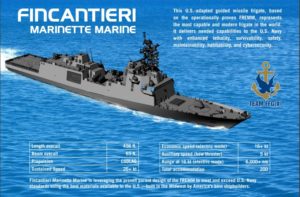Gibbs & Cox, Inc. said May 4 it will be part of the Financtieri
FFG(X) frigate team while the other competitors expressed disappointment in the loss.
Gibbs & Cox said it will serve as the design agent for the FFG(X) program and has a preexisting working relationship with the shipbuilder.

The Navy awarded Fincantieri’s Marinette Marine a $795 million detail design and construction (DD&C) contract on April 30 to deliver up to 10 total FFG(X) frigates. The immediate contract covers DD&C of the first frigate with separate options for the following nine. If all options are exercised, the contract will increase to a total of $5.6 billion (Defense Daily, April 30).
“We are pleased to continue our long-standing relationship with Fincantieri Marinette Marine and extend our partnership to a new class of ships,” Chris Deegan, Gibbs & Cox President and CEO, said in a statement.
The company is currently working with Fincantieri as design agent for the Freedom-variant Littoral Combat Ship (LCS) and Multi-Mission Surface Combatant the company builds at the Marinette Marine shipyard in Wisconsin. Lockheed Martin [LMT] is the prime contractor for the Freedom-variant while Fincantieri is the shipbuilder.
“We are excited to continue our long-standing relationship with Gibbs & Cox and look forward to continuing to work with them on this exciting program,” Dario Deste, Fincantieri Marine Group CEO, said.
Gibbs & Cox is the largest U.S. independent design agency and previously worked on the designs for the FFG-7 Oliver Hazard Perry-class frigates. The company said FFG(X) will be its 24th Navy combatant design class.
Fincantieri beat Huntington Ingalls Industries [HII], which never revealed its design but was thought to be a variant of its National Security Cutter; Austal USA with a modification of its Independence-variant LCS; and General Dynamics Bath Iron Works [GD] with a version of the Spanish F-100 frigate.
The three losing frigate bids responded to the Navy’s selection with varying degrees of disappointment.
In a quarterly earnings call with investors May 7, HII president and CEO Mike Petters said everyone in the competition was pricing a different ship and it is hard to do an apples-to-apples comparison on price alone.
“So I think the Navy try to run a best value competition and selected a winner. We’re obviously very disappointed with the way that it came out, but we’ll get a debrief from the Navy on what happened and how could have gone better and we’ll go forward from there.”
General Dynamics’ Bath Iron Works (BIW) said their team made the best bid they could.
“BIW’s FFG(X) team — including Raytheon [RTN], Navantia and our supplier base — produced an exceptional concept design and put forward the best bid possible. We look forward to the Navy’s debrief to us,” the company said in a statement April 30
BIW noted they are focusing on delivering the future USS Lyndon B. Johnson (DDG-1002), the final Zumwalt-class destroyer, and has 11 Arleigh Burke-class destroyers under contract.
“We look forward to seeing our workforce prove that they can deliver these ships on schedule and oversee the maintenance and modernization of destroyers currently deployed in the fleet,” the company added.
Austal USA also expressed its disappointment over the loss while noting the other shipbuilding it is still working on.
“Despite our extreme disappointment over this outcome, we have a portfolio of other opportunities that we continue to pursue in addition to our backlog of EPF [Spearhead-class expeditionary fast transport vessels] and LCS work that extends through 2024 including EPF variants and unmanned surface vessels.” Austal USA president Craig Perciavalle said in a statement April 30
“We have great facilities and an even greater workforce and we are committed to continuing to build highly capable and cost effective ships for the U.S. Navy,” he added.